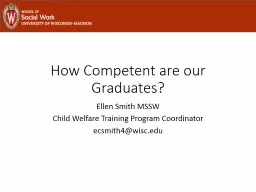

Ellen Smith MSSW Child Welfare Training Program Coordinator ecsmith4wiscedu Objectives Share program information Discuss development process Share preliminary results Discuss future directions ID: 189897
Download Presentation The PPT/PDF document "How Competent are our Graduates?" is the property of its rightful owner. Permission is granted to download and print the materials on this web site for personal, non-commercial use only, and to display it on your personal computer provided you do not modify the materials and that you retain all copyright notices contained in the materials. By downloading content from our website, you accept the terms of this agreement.
Slide1
How Competent are our Graduates?
Ellen Smith MSSWChild Welfare Training Program Coordinatorecsmith4@wisc.eduSlide2
Objectives
Share program informationDiscuss development process
Share preliminary resultsDiscuss future directionsSlide3
UW Madison Child Welfare Training Programs
BSW Program-
Small (4-5 students)Senior year onlyMSW Full Time ProgramTuition and Stipends10-15 studentsMSW Part Time Program
Madison and Eau Claire
4 year Saturday Program (generalist)
2 year Saturday Program (advanced Standing)
10-15 students spread across both programsSlide4
Outcome Study
CSWE Competencies
Pre/post test by students- self report measureEvaluated in the field at the end of each semester-by field faculty and agency supervisorChild Welfare Tasks
Pre/post test by Students
NEW: evaluation by agency supervisor
Outcome study has been administer for 15 years but measures have changed over time.
First year of data for Child Welfare CompetenciesSlide5
Child Welfare Competencies
Worked with the Department of Children and Families to develop a Child Welfare Practice Model
http://www.dcf.wi.gov/children/practice_model/pdf/wisconsin_practice_model.pdfDeveloped Child Welfare Competencies from Standards, CSWE Competencies and the Practice ModelSelected relevant competencies for beginning practice/IV-E graduatesThe relevant competencies includes a 140 items including 16 broad competencies and 124 sub-competenciesSlide6
Competencies Measured
Identify as a child welfare professional and conduct yourself accordingly.
Demonstrate Cultural CompetenceFully inform the family (including extended family) of what to expect across the case process
Assure that there is full disclosure, both verbally and in writing, to the parent’s/caregivers so that they fully understand the need for timely permanence for their child throughout the life of a case
Ensure Child Safety
Accurately assess family functioning as it relates to the children’s safety, permanence, and well-beingSlide7
Utilize developmental theories to inform the assessment of strength/needs of child and family across the lifespan
Utilize critical thinking to inform and communicate professional judgment
Make decisions based on Standards and information gatheredEffectively collaborate with all relevant case participants
Work effectively with and meet all requirements when working with the court system (judge, D.A., Corp Counsel, GAL, adverse council)
Meet all requirements and use best practice when placing a child in out of home care
Facilitate planning with the family and their team which will result in sustainable change, maximizing the assurance of safety, permanence, and well-being for the child(
ren
) (this includes tracking and adjusting)Slide8
Assure that active and reasonable efforts are made to achieve permanence, that is, every child has a safe, stable, and permanent home prior to case closure
Prepare Youth for Independent Living
Close a case in a way that maximizes the likelihood of sustainable changeSlide9
Generalist Competencies
Advanced Practice Competencies
Competency
Exit Mean
Change Mean
Exit Mean
Change Mean
Identify as a child welfare professional and conduct yourself accordingly.
3.87
1.04
4.27
1.01
Demonstrate cultural competence.
3.91
0.86
4.48
1.00
Fully inform the family (including extended family) of what to expect across the case process.
3.51
1.29
3.59
1.01
Assure that there is full disclosure, both verbally and in writing, to the parents/caregivers so that they fully understand the need for timely permanence for their child throughout the life of the case.
3.52
1.11
3.63
0.68
Ensure child safety.
3.06
1.23
3.57
1.13
Worker can accurately assess family functioning as it relates to children’s safety, permanence and well-being.
3.48
1.41
3.91
0.89
Use developmental theories to inform the assessment of strengths/needs of child and family across the lifespan.
3.82
1.55
4.20
1.14
Utilize critical thinking to inform and communicate professional judgment.
3.71
0.91
4.35
0.90
Make decisions based on standards and
information
gathered.
2.92
1.22
3.15
1.02
Effectively collaborate with all relevant case participants.
3.24
0.67
3.61
0.79
Work effectively with and meet all requirements when working with court system (judges, D.A, Corp Counsel, CASA, GAL, other counsel).
2.56
0.29
2.76
0.81
Meet all requirements and use best practices when placing a child in out-of-home care.
2.84
1.11
3.19
0.90
Facilitate planning with the family and their team, which will result in sustainable. change, maximizing the assurance of safety, permanence and well-being for the child(
ren
). (This includes tracking and adjusting.)
2.97
0.99
3.63
0.91
Assure that active and reasonable efforts are made to achieve permanence, that is, every child has a safe, stable, and permanent home prior to case closure.
2.41
0.91
2.55
0.78
Prepare Youth
for Independent living
1.06
-0.10
1.55
0.77
Close a case in a way that maximizes the likelihood of sustainable change.
2.52
0.94
2.69
0.64Slide10
Example of Competency and sub-items
Make decisions on standards and information given:
Determine if WICWA is applicable in each case.Determine if alternative or traditional response is appropriate for family.Document referral and coordination with the Birth-to-3 program in
eWiSACWIS
.
Determine whether case will be screened in or out
.
Determine whether report is a services or CPS case
.
Determine response time
.
Determine if the case is to be opened
.
Determine if there is a need for court intervention
.
Determine what is needed to support a safe, stable and permanent home
.
Make case finding determinations.
Students rated themselves 1 point higher on more general competency than the more specific onesSlide11
Interesting findings…for now
Students rated themselves higher with the competencies then the individual practice behaviors
Student overall assessment of competence very lowSome areas clearly need more attention either in field or in the classroomSlide12
Next Steps
Analyze differences between self-report measure and field evaluation
Look for differences in CSWE competencies and Child Welfare CompetenciesLongitudinal data collectionIs there any correlation to performance in the field after graduation?Curriculum revisions